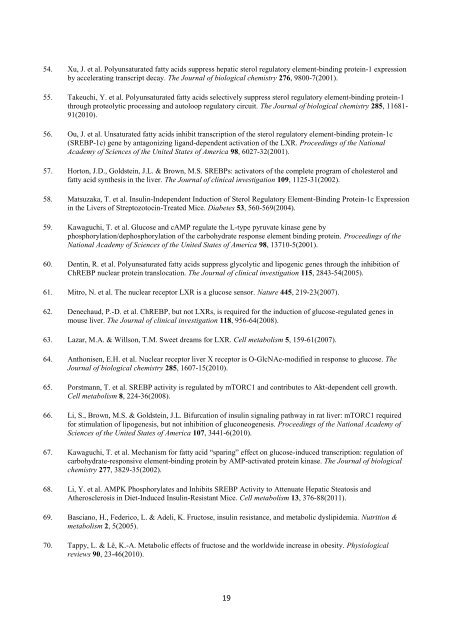The obesogenic effects of polyunsaturated fatty acids are dependent ...
The obesogenic effects of polyunsaturated fatty acids are dependent ...
The obesogenic effects of polyunsaturated fatty acids are dependent ...
Create successful ePaper yourself
Turn your PDF publications into a flip-book with our unique Google optimized e-Paper software.
54. Xu, J. et al. Polyunsaturated <strong>fatty</strong> <strong>acids</strong> suppress hepatic sterol regulatory element-binding protein-1 expression<br />
by accelerating transcript decay. <strong>The</strong> Journal <strong>of</strong> biological chemistry 276, 9800-7(2001).<br />
55. Takeuchi, Y. et al. Polyunsaturated <strong>fatty</strong> <strong>acids</strong> selectively suppress sterol regulatory element-binding protein-1<br />
through proteolytic processing and autoloop regulatory circuit. <strong>The</strong> Journal <strong>of</strong> biological chemistry 285, 11681-<br />
91(2010).<br />
56. Ou, J. et al. Unsaturated <strong>fatty</strong> <strong>acids</strong> inhibit transcription <strong>of</strong> the sterol regulatory element-binding protein-1c<br />
(SREBP-1c) gene by antagonizing ligand-<strong>dependent</strong> activation <strong>of</strong> the LXR. Proceedings <strong>of</strong> the National<br />
Academy <strong>of</strong> Sciences <strong>of</strong> the United States <strong>of</strong> America 98, 6027-32(2001).<br />
57. Horton, J.D., Goldstein, J.L. & Brown, M.S. SREBPs: activators <strong>of</strong> the complete program <strong>of</strong> cholesterol and<br />
<strong>fatty</strong> acid synthesis in the liver. <strong>The</strong> Journal <strong>of</strong> clinical investigation 109, 1125-31(2002).<br />
58. Matsuzaka, T. et al. Insulin-In<strong>dependent</strong> Induction <strong>of</strong> Sterol Regulatory Element-Binding Protein-1c Expression<br />
in the Livers <strong>of</strong> Streptozotocin-Treated Mice. Diabetes 53, 560-569(2004).<br />
59. Kawaguchi, T. et al. Glucose and cAMP regulate the L-type pyruvate kinase gene by<br />
phosphorylation/dephosphorylation <strong>of</strong> the carbohydrate response element binding protein. Proceedings <strong>of</strong> the<br />
National Academy <strong>of</strong> Sciences <strong>of</strong> the United States <strong>of</strong> America 98, 13710-5(2001).<br />
60. Dentin, R. et al. Polyunsaturated <strong>fatty</strong> <strong>acids</strong> suppress glycolytic and lipogenic genes through the inhibition <strong>of</strong><br />
ChREBP nuclear protein translocation. <strong>The</strong> Journal <strong>of</strong> clinical investigation 115, 2843-54(2005).<br />
61. Mitro, N. et al. <strong>The</strong> nuclear receptor LXR is a glucose sensor. Nature 445, 219-23(2007).<br />
62. Denechaud, P.-D. et al. ChREBP, but not LXRs, is required for the induction <strong>of</strong> glucose-regulated genes in<br />
mouse liver. <strong>The</strong> Journal <strong>of</strong> clinical investigation 118, 956-64(2008).<br />
63. Lazar, M.A. & Willson, T.M. Sweet dreams for LXR. Cell metabolism 5, 159-61(2007).<br />
64. Anthonisen, E.H. et al. Nuclear receptor liver X receptor is O-GlcNAc-modified in response to glucose. <strong>The</strong><br />
Journal <strong>of</strong> biological chemistry 285, 1607-15(2010).<br />
65. Porstmann, T. et al. SREBP activity is regulated by mTORC1 and contributes to Akt-<strong>dependent</strong> cell growth.<br />
Cell metabolism 8, 224-36(2008).<br />
66. Li, S., Brown, M.S. & Goldstein, J.L. Bifurcation <strong>of</strong> insulin signaling pathway in rat liver: mTORC1 required<br />
for stimulation <strong>of</strong> lipogenesis, but not inhibition <strong>of</strong> gluconeogenesis. Proceedings <strong>of</strong> the National Academy <strong>of</strong><br />
Sciences <strong>of</strong> the United States <strong>of</strong> America 107, 3441-6(2010).<br />
67. Kawaguchi, T. et al. Mechanism for <strong>fatty</strong> acid “sparing” effect on glucose-induced transcription: regulation <strong>of</strong><br />
carbohydrate-responsive element-binding protein by AMP-activated protein kinase. <strong>The</strong> Journal <strong>of</strong> biological<br />
chemistry 277, 3829-35(2002).<br />
68. Li, Y. et al. AMPK Phosphorylates and Inhibits SREBP Activity to Attenuate Hepatic Steatosis and<br />
Atherosclerosis in Diet-Induced Insulin-Resistant Mice. Cell metabolism 13, 376-88(2011).<br />
69. Basciano, H., Federico, L. & Adeli, K. Fructose, insulin resistance, and metabolic dyslipidemia. Nutrition &<br />
metabolism 2, 5(2005).<br />
70. Tappy, L. & Lê, K.-A. Metabolic <strong>effects</strong> <strong>of</strong> fructose and the worldwide increase in obesity. Physiological<br />
reviews 90, 23-46(2010).<br />
19
















